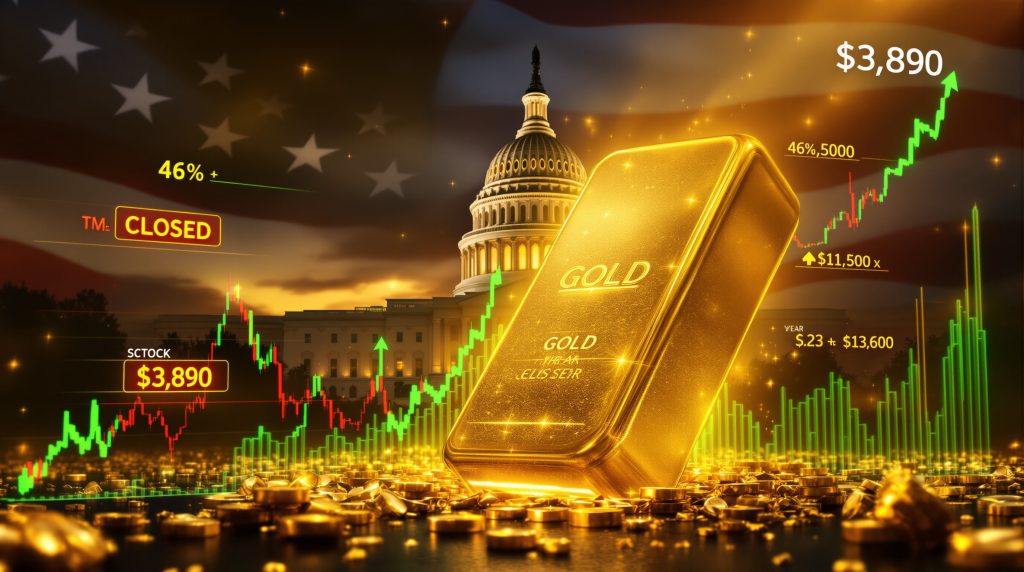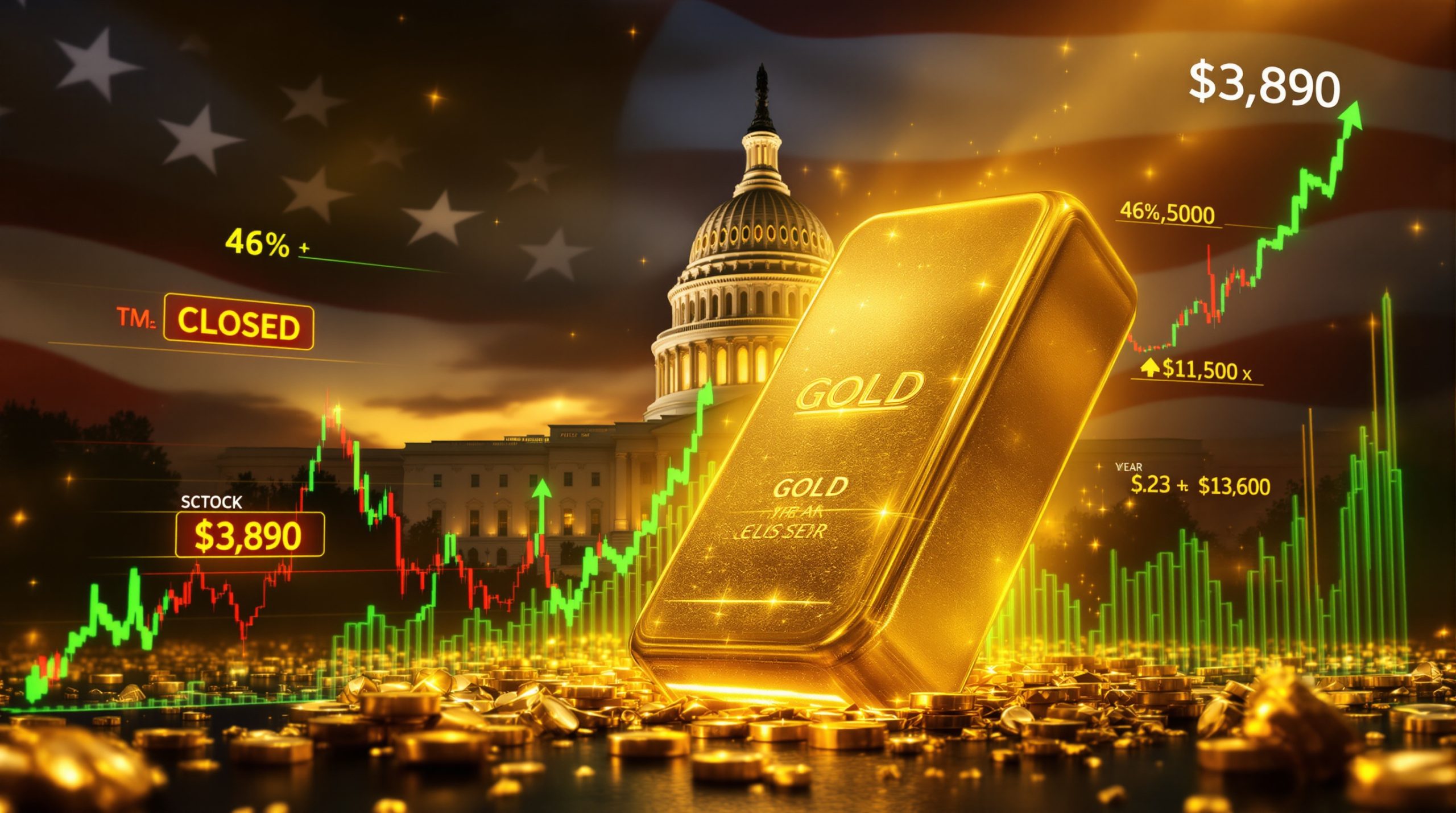Why Is Gold Hitting Record Highs During the US Government Shutdown?
Gold prices have shattered previous records, climbing above $3,890 per ounce in October 2025, marking the third consecutive session of all-time highs analysis. This remarkable surge coincides with the commencement of a U.S. federal government shutdown, highlighting gold's enduring role as a safe-haven asset during periods of political and economic uncertainty.
Understanding Gold's Record-Breaking Rally
The precious metal's dramatic rise represents a nearly 46% increase year-over-year, significantly outperforming many traditional investment assets. Market analysts point to a perfect storm of factors driving this unprecedented rally, including political gridlock, monetary policy expectations, and global uncertainty.
Gold's market performance amid surge stands in stark contrast to the mixed reactions seen across broader financial markets, where stock futures declined while certain European markets showed resilience.
Historically, gold has served as a refuge during times of market turbulence and political discord, but the magnitude of the current rally exceeds typical patterns observed during previous government shutdowns.
What Caused the US Government Shutdown?
Political Gridlock and Budget Impasse
The shutdown began at 12:01 a.m. EDT on October 1 after Congress failed to pass either a comprehensive budget or a stopgap funding measure. Negotiations collapsed amid fundamental disagreements between Republican and Democratic lawmakers over several key issues:
- Proposed changes to welfare payment structures
- Tax policy reforms
- Federal spending priorities
The House of Representatives managed to pass a temporary funding bill, but Senate Democrats blocked its progress by invoking the filibuster rule, effectively preventing the legislation from reaching the 60-vote threshold needed for passage.
Political analysts note that the current shutdown reflects deeper ideological divides that have become increasingly difficult to bridge in recent years, with both sides appearing unwilling to compromise on core principles.
Economic and Administrative Impact
The shutdown's immediate consequences include:
- Approximately 750,000 federal employees furloughed without pay
- An estimated daily economic cost of $400 million
- Suspension of non-essential government services
- Delayed release of critical economic data reports
Unlike previous shutdowns, the current impasse occurs against the backdrop of significant economic uncertainty, with markets already on edge due to inflation concerns and slowing growth in certain sectors.
How Is the Shutdown Affecting Financial Markets?
Delayed Economic Data and Market Uncertainty
One of the most significant market impacts is the expected delay of the September employment report, which was scheduled for release on Friday. The Bureau of Labor Statistics has confirmed that under its emergency plan, such data will not be published during the shutdown period.
This data vacuum creates substantial challenges for investors and policymakers alike:
- The Federal Reserve relies heavily on employment figures when making interest rate decisions
- Market participants use this data to gauge economic health and adjust investment strategies
- Without official statistics, alternative indicators like the ADP National Employment Report gain heightened importance
Financial analysts emphasize that data delays create a "flying blind" scenario for investors, potentially increasing market volatility as decisions must be made with incomplete information.
Investor Sentiment and Market Reactions
The market response has been mixed but revealing:
- U.S. stock futures declined, with S&P 500 and Nasdaq futures dropping approximately 0.6% each
- The dollar index slipped for the fourth consecutive day, down 0.2% to 97.59
- European shares showed resilience, with the pan-continental STOXX 600 rising 0.4%
- British and Swiss markets outperformed, boosted by healthcare stocks
The divergence between U.S. and European market performance highlights the localized impact of the shutdown, with domestic markets experiencing greater pressure than their international counterparts.
Why Is Gold Surging During This Crisis?
Safe-Haven Appeal in Uncertain Times
Gold's remarkable performance during this period can be attributed to several interconnected factors:
- Political instability: The government shutdown represents a breakdown in governance that typically drives investors toward tangible assets
- Monetary policy expectations: Markets now imply a high probability of a Federal Reserve rate cut, creating favorable conditions for non-yielding assets like gold
- Inflationary concerns: Potential economic disruption from the shutdown could impact price stability
- Global geopolitical tensions: Ongoing conflicts and trade disputes enhance gold's traditional safe-haven status
Market analysts note that when conventional economic indicators become unreliable during shutdowns, investors tend to place greater value on physical assets with intrinsic worth.
Historical Context of Gold During Government Shutdowns
While each government shutdown has unique characteristics, gold has historically demonstrated resilience during these periods. The current rally builds on this pattern but is notable for its magnitude and the record highs as inflation hedge.
Data from previous shutdowns shows variable impacts on gold prices, but the current situation features a more pronounced positive correlation, suggesting heightened investor anxiety compared to past episodes.
"When political uncertainty combines with economic concerns, gold typically benefits more significantly than during shutdowns occurring against stronger economic backdrops," according to Reuters analysts.
What Are the Global Implications?
International Market Responses
The impact extends well beyond U.S. borders:
- Japanese markets dropped 0.9% after an 11% surge in the previous quarter
- South Korean shares rose 0.9%, building on a 11.5% gain last quarter
- Taiwan's shares gained 0.6% amid ongoing semiconductor production negotiations with the U.S.
- Chinese markets were closed for a public holiday
These mixed responses reflect varying degrees of economic interconnection with the U.S. and different assessments of the shutdown's potential spillover effects.
Currency Market Dynamics
The dollar's weakness has contributed to gold's strength:
- The euro rose 0.2% to $1.1756
- Sterling increased 0.2% to $1.3474
- The dollar fell 0.6% against the Japanese yen to 147.06
Currency markets are particularly sensitive to U.S. political developments, as they directly impact interest rate expectations and international trade relationships.
How Long Might the Shutdown Last?
Historical Precedents and Current Indicators
Previous government shutdowns have varied dramatically in duration:
- The 2018-2019 shutdown lasted 35 days, the longest in U.S. history
- The 2013 shutdown continued for 16 days
- Most shutdowns since 1980 have been resolved within one to three weeks
The current political landscape suggests a potentially prolonged impasse, with both sides showing limited willingness to compromise on core issues.
Political scientists note that as shutdowns extend beyond the one-week mark, public pressure typically intensifies, often becoming a key factor in eventual resolution.
Economic Pressure Points
Several factors may accelerate resolution efforts:
- Mounting economic costs ($400 million daily)
- Public pressure as services remain suspended
- Market volatility if uncertainty persists
- Delayed economic data hampering policy decisions
The financial impact of shutdowns typically follows a non-linear pattern, with costs accelerating as duration increases and more government functions are affected.
What Should Investors Consider?
Strategic Implications for Portfolios
The current environment presents both challenges and opportunities:
- Diversification value: Gold's performance reinforces its role as a portfolio diversifier during periods of market stress
- Inflation hedge: The metal continues to serve as protection against potential inflationary pressures
- Liquidity considerations: Gold markets remain highly liquid even during periods of stress
- Entry point assessment: Current record prices prompt questions about sustainable valuation
Financial advisors suggest that while gold has demonstrated impressive performance, investors should avoid overconcentration and maintain balanced exposure across asset classes.
Beyond Gold: Other Safe-Haven Assets
While gold has captured headlines, other traditional safe havens have shown varied responses:
- U.S. Treasury yields remained relatively stable, with the benchmark 10-year yield flat at 4.156%
- Silver has also performed strongly, mirroring gold's trajectory
- The Japanese yen strengthened against the dollar following positive manufacturing data
This divergence in safe-haven performance highlights the unique nature of the current crisis, with investors showing preferences for certain hedging strategies over others.
What's Next for Gold Prices?
Technical and Fundamental Outlook
Several factors will influence gold's trajectory in the coming weeks:
- Duration of the government shutdown: A prolonged impasse could further support prices
- Federal Reserve policy decisions: Expected rate cuts would typically benefit gold
- Economic data releases: Once available, employment and inflation figures will provide crucial context
- Resolution of political gridlock: Any breakthrough in budget negotiations could trigger profit-taking
Technical analysts note that while gold's momentum remains strong, the rapid ascent may create conditions for short-term consolidation or pullbacks as investors reassess value.
Market Sentiment Indicators
Current market positioning suggests continued bullish sentiment:
- Futures markets show sustained speculative interest
- Physical demand remains robust across major markets
- Central bank purchasing continues to provide underlying support
- Technical indicators point to potential consolidation after the rapid ascent
Trading volume and options positioning indicate significant institutional interest in maintaining gold exposure through the current period of uncertainty.
Long-Term Implications for Gold Investment
Structural Factors Supporting Gold
Beyond the immediate crisis, several fundamental factors continue to support gold's gold price forecast:
- Central bank diversification away from traditional reserve currencies
- Growing sovereign debt levels across major economies
- Ongoing currency debasement concerns
- Increasing retail investor interest in precious metals
Investment strategists suggest that while short-term price movements may be volatile, these structural factors provide a favorable backdrop for gold over extended time horizons.
Portfolio Allocation Considerations
Financial advisors recommend that investors consider:
- Using market volatility to rebalance positions rather than making dramatic allocation changes
- Maintaining gold exposure as a percentage of overall portfolio rather than focusing on absolute price levels
- Considering various forms of gold investment (physical, ETFs, mining stocks) based on individual objectives
- Remaining mindful of gold's historical tendency to experience periodic corrections even during bull markets
A balanced approach recognizes gold's value as a portfolio component while acknowledging that no single asset offers complete protection against all forms of market risk.
Conclusion: Gold's Role in Uncertain Times
The U.S. government shutdown has catalyzed gold's surge to unprecedented heights, highlighting the metal's enduring appeal during periods of political and economic uncertainty. As the situation evolves, investors will closely monitor both the duration of the shutdown and its broader implications for monetary policy, economic growth, and market stability.
The current gold rally represents more than just a reaction to temporary political dysfunction—it reflects deeper concerns about economic resilience, inflation risks, and the complex interplay between fiscal and monetary policy in an increasingly uncertain global landscape.
While predicting short-term price movements remains challenging, gold's historical performance during similar crises suggests it will continue to play a significant role in investment strategies for gold designed to navigate periods of heightened uncertainty and volatility.
Ready to Invest in Gold During Market Uncertainty?
Discover how to identify high-potential ASX gold stocks with Discovery Alert's proprietary Discovery IQ model, which turns complex market data into actionable insights during volatile periods like the US government shutdown. Visit the Discovery Alert discoveries page to see how major mineral discoveries have historically generated exceptional returns for early investors.




